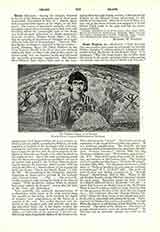

Orans (ORANTE).—Among the subjects depicted in the art of the Roman catacombs one of those most numerously represented is that of a female figure with extended arms known as the Orans, or one who prays. The custom of praying in antiquity with out-stretched, raised arms was common to both Jews and Gentiles; indeed the iconographic type of the Orans was itself strongly influenced by classic representations (see Leclercq, “Manuel d’arch. chret.”, I, 155). But the meaning of the Orans of Christian art is quite different from that of its prototypes. Numerous Biblical figures, for instance, depicted in the catacombs—Noah, Abraham, Isaac, the Three Children in the Fiery Furnace, Daniel in the lions’ den—are pictured asking the Lord to deliver the soul of the person on whose tombs they are depicted as He once delivered the particular personage represented. But besides these Biblical Orans figures there exist in the catacombs many ideal figures (153 in all) in the ancient attitude of prayer, which, according to Wilpert, are to be regarded as symbols of the deceased’s soul in heaven, praying for its friends on earth. This symbolic meaning accounts for the fact that the great majority of the figures of this order are female, even when depicted on the tombs of men. One of the most convincing proofs that the Orans was regarded as a symbol of the. soul is an ancient lead medal in the Vatican Museum showing the martyr, St. Lawrence, under torture, while his soul, in the form of a female Orans, is just leaving the body (see Kraus, “Gesch. der christl. Kunst”, I, 126, fig. 56). An arcosolium in the Ostrianum cemetery represents an Orans with a petition for her intercession: Victorice Virgini … Pete. . The Acts of St. Cecilia speaks of souls leaving the body in the form of virgins: “Vidit egredientes animas eorum de corporibus, quasi virgines de thalamo”, and so also the Acts of Sts. Peter and Marcellinus.
Very probably the medieval representations of a diminutive body, figure of the soul, issuing from the mouths of the dying, to be received by angels or demons, were reminiscences of the Orans as a symbol of the soul. The earlier Orantes were depicted in the simplest garb, and without any striking individual traits, but in the fourth century the figures become richly adorned, and of marked individuality—an indication of the approach of historic art. One of the most remarkable figures of the Orans cycle, dating from the early fourth century, is interpreted by Wilpert as the Blessed Virgin interceding for the friends of the deceased. Directly in front of Mary is a boy, not in the Orans attitude and supposed to be the Divine Child, while to the right and left are monograms of Christ.
MAURICE M. HASSETT

